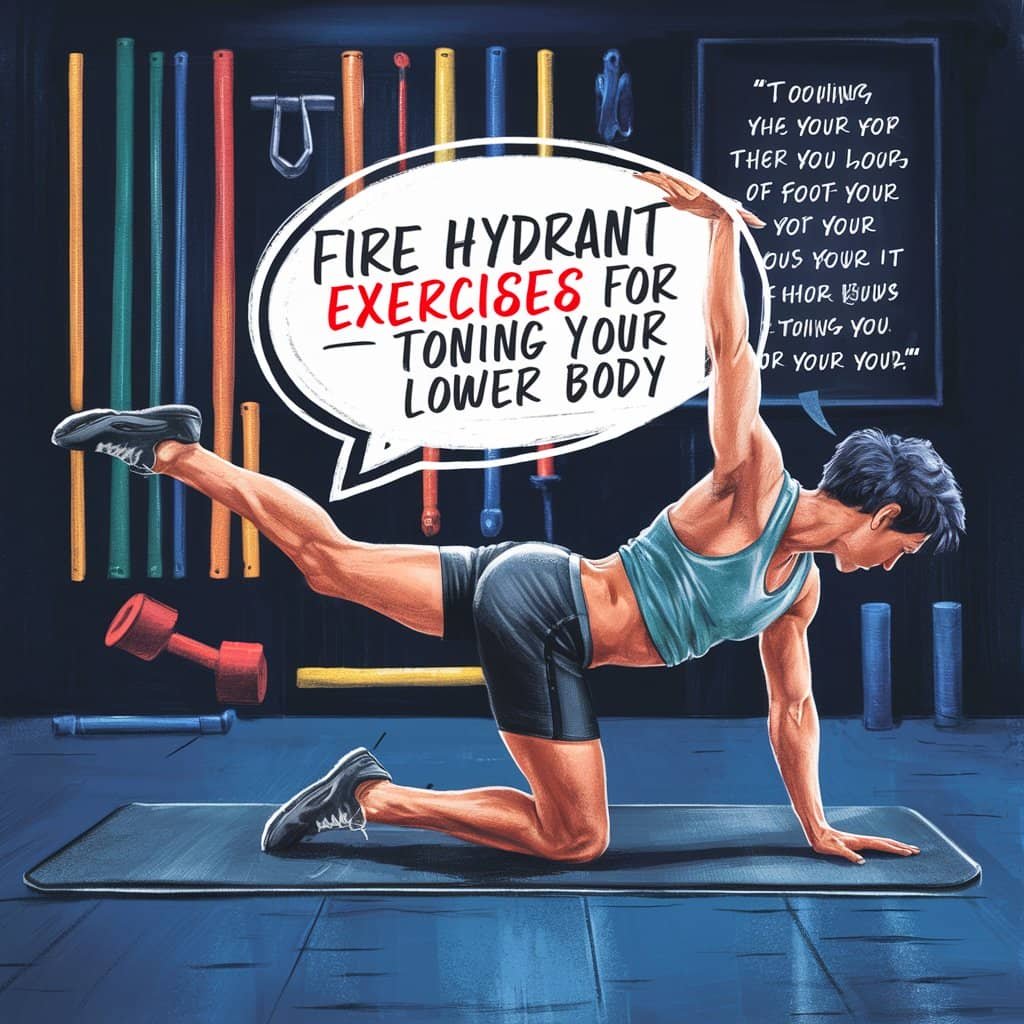Introduction at Fire Hydrant Exercises for Toning
Are you looking for effective exercises to tone and strengthen your lower body? Look no further than the fire hydrant exercise! This simple yet powerful move targets your glutes, hips, and thighs, helping you achieve a firmer, more sculpted appearance. In this blog post, we’ll explore five variations of the fire hydrant exercise that will take your lower body workouts to the next level.
1. Classic Fire Hydrant
The classic fire hydrant is the foundation for all the variations we’ll discuss. Here’s how to perform it:
- Start on all fours with your hands under your shoulders and your knees under your hips.
- Keeping your knee bent at a 90-degree angle, lift your right leg out to the side until it’s parallel to the ground.
- Squeeze your glutes at the top of the movement, then lower your leg back to the starting position.
- Repeat for the desired number of reps, then switch sides.
Pro tip: Focus on keeping your core engaged and your back straight throughout the exercise to maintain proper form and maximize the benefits.
2. Pulse Fire Hydrant
Add an extra challenge to the classic fire hydrant by incorporating pulses:
- Begin in the same starting position as the classic fire hydrant.
- Lift your right leg out to the side until it’s parallel to the ground.
- At the top of the movement, perform small pulses by lifting your leg slightly higher and then lowering it back to the parallel position.
- Continue pulsing for the desired number of reps, then lower your leg back to the starting position and switch sides.
Pro tip: Aim for controlled, deliberate pulses to really feel the burn in your glutes and hips.
3. Fire Hydrant with Leg Extension
Take your fire hydrant to the next level by adding a leg extension:
- Start in the classic fire hydrant position.
- As you lift your right leg out to the side, extend it straight behind you, forming a straight line from your heel to your hip.
- Hold for a moment, then bend your knee and return to the starting position.
- Repeat for the desired number of reps, then switch sides.
Pro tip: Keep your hips square to the ground throughout the movement to ensure you’re targeting the right muscles.
4. Fire Hydrant with Resistance Band
Incorporating a resistance band into your fire hydrant exercise adds an extra challenge and increases the intensity:
- Place a resistance band around your thighs, just above your knees.
- Begin in the classic fire hydrant position.
- As you lift your right leg out to the side, press against the resistance band, feeling the added tension in your glutes and hips.
- Lower your leg back to the starting position, maintaining tension on the band throughout the movement.
- Repeat for the desired number of reps, then switch sides.
Pro tip: Choose a resistance band that provides enough challenge without compromising your form.
5. Fire Hydrant Kick
Add a dynamic element to your fire hydrant exercise with this kicking variation:
- Start in the classic fire hydrant position.
- As you lift your right leg out to the side, kick it forward, extending your leg straight out in front of you.
- Return your leg to the lifted position, then lower it back to the starting position.
- Repeat for the desired number of reps, then switch sides.
Pro tip: Maintain a controlled motion throughout the exercise, focusing on engaging your glutes and core.
6. Fire Hydrant with Ankle Weights
Amp up the intensity of your fire hydrant exercise by adding ankle weights:
- Strap on a pair of ankle weights (start with 1-2 pounds and gradually increase as you build strength).
- Begin in the classic fire hydrant position.
- Lift your right leg out to the side, feeling the added resistance from the ankle weights.
- Hold for a moment at the top of the movement, then lower your leg back to the starting position.
- Repeat for the desired number of reps, then switch sides.
Pro tip: Be mindful of your form and avoid arching your back or leaning to one side to compensate for the added weight.
7. Fire Hydrant with Knee Circle
Add a dynamic element to your fire hydrant exercise with knee circles:
- Start in the classic fire hydrant position.
- Lift your right leg out to the side until it’s parallel to the ground.
- At the top of the movement, make small, controlled circles with your knee, as if you’re tracing a circle on the ceiling.
- Complete the desired number of circles in one direction, then reverse the direction for the same number of reps.
- Lower your leg back to the starting position and switch sides.
Pro tip: Keep your circles small and controlled, focusing on engaging your glutes and hips throughout the movement.
8. Plank Fire Hydrant
Challenge your core and glutes simultaneously with the plank fire hydrant:
- Start in a high plank position with your hands directly under your shoulders and your feet together.
- Keeping your right knee bent at a 90-degree angle, lift your right leg out to the side until your thigh is parallel to the ground.
- Hold for a moment, then lower your leg back to the starting position.
- Repeat for the desired number of reps, then switch sides.
Pro tip: Maintain a straight line from your head to your heels throughout the exercise, engaging your core to prevent your hips from sagging or rotating.
9. Fire Hydrant with Resistance Band and Pulse
Combine the resistance band and pulse variations for an extra-challenging fire hydrant exercise:
- Place a resistance band around your thighs, just above your knees.
- Begin in the classic fire hydrant position.
- As you lift your right leg out to the side, press against the resistance band until your leg is parallel to the ground.
- At the top of the movement, perform small pulses by lifting your leg slightly higher and then lowering it back to the parallel position.
- Continue pulsing for the desired number of reps, then lower your leg back to the starting position and switch sides.
Pro tip: Focus on maintaining tension on the resistance band throughout the entire movement for maximum glute and hip engagement.
10. Fire Hydrant Hold
Develop isometric strength in your glutes and hips with the fire hydrant hold:
- Start in the classic fire hydrant position.
- Lift your right leg out to the side until it’s parallel to the ground.
- Hold this position for 15-30 seconds, focusing on squeezing your glutes and engaging your core.
- Lower your leg back to the starting position and switch sides.
Pro tip: As you build strength, gradually increase the duration of your holds to further challenge your muscles.
11. Fire Hydrant with Toe Tap
Add a balance challenge to your fire hydrant exercise with toe taps:
- Begin in the classic fire hydrant position.
- Lift your right leg out to the side until it’s parallel to the ground.
- At the top of the movement, tap your right toes on the ground just outside your left foot.
- Lift your leg back to the parallel position, then lower it back to the starting position.
- Repeat for the desired number of reps, then switch sides.
Pro tip: Focus on maintaining a stable core and a steady tempo throughout the movement to improve your balance and coordination.
12. Fire Hydrant with Glute Squeeze
Emphasize glute engagement with this fire hydrant variation:
- Start in the classic fire hydrant position.
- Lift your right leg out to the side until it’s parallel to the ground.
- At the top of the movement, pause and consciously squeeze your glutes for 2-3 seconds.
- Lower your leg back to the starting position, maintaining the glute squeeze throughout the descent.
- Repeat for the desired number of reps, then switch sides.
Pro tip: Visualize squeezing a walnut between your glutes to help you maintain the contraction throughout the exercise.
13. Fire Hydrant Combo
Create a dynamic, full-body workout by combining fire hydrants with other exercises:
- Perform a classic fire hydrant with your right leg for the desired number of reps.
- Immediately transition into a push-up, maintaining proper form.
- Return to the starting position and repeat the fire hydrant with your left leg.
- Continue alternating between fire hydrants and push-ups for the desired number of sets.
Pro tip: Customize this combo by incorporating other exercises like mountain climbers, plank jacks, or burpees to target different muscle groups and keep your workouts engaging.
By incorporating these additional fire hydrant variations into your lower body workouts, you’ll continue to challenge your glutes, hips, and thighs in new and exciting ways. Remember to listen to your body, maintain proper form, and gradually increase the difficulty as you build strength and endurance.
Mix and match these variations to create dynamic, effective workouts that keep you motivated and help you achieve your fitness goals. Share your favorite fire hydrant combos and progress in the comments below, and let’s continue to inspire and support one another on our fitness journeys!
Conclusion
Incorporating these five fire hydrant variations into your lower body workouts will help you target your glutes, hips, and thighs from different angles, leading to better overall toning and strength. Remember to maintain proper form, engage your core, and listen to your body as you progress through each exercise.
Start with the classic fire hydrant and gradually work your way up to the more advanced variations as you build strength and confidence. Consistency is key, so aim to include these exercises in your routine 2-3 times per week for optimal results.
Now that you’re armed with these powerful fire hydrant exercises, it’s time to put them into action and start sculpting the strong, toned lower body you’ve always wanted. Share your progress and favorite variations in the comments below, and let’s support each other on this fitness journey!
























